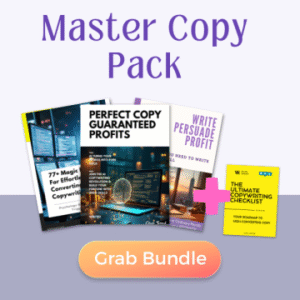Understanding copywriting advertising meaning helps businesses create messages that drive action. Copywriting in advertising refers to the strategic craft of writing persuasive text that motivates audiences to take specific actions. This specialized form of writing combines psychology and creativity to sell products and build brand awareness. Every successful marketing campaign relies on effective copywriting to deliver its message. The power of well-crafted copy transforms casual browsers into loyal customers and generates measurable business growth.
What is copywriting in advertising?
Copywriting forms the backbone of effective advertising across all mediums. It involves creating compelling written content that persuades readers to respond. Unlike other types of writing, advertising copy aims to trigger immediate emotional and logical responses. Copywriters craft headlines, taglines, product descriptions, email campaigns, and social media posts. They translate complex features into clear benefits that resonate with target audiences.
The fundamental purpose of copywriting extends beyond mere information sharing. Good copy creates desire and urgency while addressing customer pain points. It builds trust through authentic communication and positions brands as solutions. Effective copywriters understand their audience deeply and speak directly to their needs. This understanding allows them to create messages that feel personally relevant to each reader.
Related articles:
- Master Ads Copywriting to double your conversion rates
- Copywriting in advertising examples & proven techniques
- Copywriting tips for facebook ads to maximize ROI
- Copywriting in ads: Master the art of persuasive advertising
The historical evolution of advertising copywriting
Advertising copy has evolved dramatically over the past century. Early print advertisements featured lengthy, information-heavy text that explained product features. The 1920s introduced emotional appeals and benefit-focused messaging that connected with consumers. David Ogilvy and other pioneers developed techniques that still influence modern copywriting approaches.
The digital revolution transformed copywriting requirements and opportunities for brands. Messages became shorter as attention spans decreased in online environments. Social media introduced character limits and new content formats for creative expression. Mobile devices created demand for concise yet compelling messages that work on small screens.
Today, copywriting advertising meaning encompasses multichannel approaches that maintain consistency. Voice search and AI assistants require conversational writing styles that sound natural. Video platforms demand scripts that capture attention within seconds of viewing. Each evolution expands the copywriter’s toolkit while reinforcing fundamental persuasion principles.
Key elements of effective advertising copy
Strong advertising copy contains several essential components that drive results. Headlines grab attention and communicate core benefits within seconds of exposure. Subheadings maintain interest and guide readers through logical information sequences. Body copy elaborates on promises made in headlines while maintaining engagement throughout.
The tone and voice must align perfectly with brand identity and audience expectations. Luxury products require sophisticated language that conveys exclusivity and refinement. Budget-friendly offerings need approachable copy that emphasizes value and practicality. Consistency across all touchpoints builds recognition and trust with consumers.
Calls to action provide clear direction that eliminates purchase hesitation. Strong CTAs create urgency without appearing manipulative or desperate. They guide consumers through the next steps in their journey with the brand. Effective calls to action use active verbs that inspire immediate response.
The psychology behind persuasive copywriting
Understanding human psychology gives copywriters powerful tools for message creation. The principle of scarcity makes limited-time offers particularly compelling for consumers. Social proof through testimonials and reviews reduces perceived risk in purchase decisions. Authority positioning builds credibility that supports claims made in advertisements.
Emotional triggers often drive purchasing decisions more than logical reasoning. Fear of missing opportunities motivates quick action from potential customers. Desire for belonging influences brand choices that signal group membership. Hope for improvement connects products with aspirational self-images held by consumers.
Cognitive biases also influence how audiences process advertising messages. The anchoring effect shapes perceived value through strategic price presentation. Confirmation bias makes consumers receptive to messages that align with existing beliefs. Understanding these psychological factors helps copywriters craft messages that resonate deeply.
Copywriting formulas that drive results
Professional copywriters rely on proven formulas to structure persuasive messages. The AIDA model guides consumers from Attention to Interest to Desire to Action. PAS identifies a Problem, agitates it, then presents a Solution that motivates purchase. FAB connects Features with Advantages and Benefits that matter to consumers.
The “4 Cs” formula ensures copy remains Clear, Concise, Compelling, and Credible. The 4 Ps approach positions copy around Promise, Picture, Proof, and Push elements. These frameworks provide reliable structures for creating effective marketing messages. They help copywriters organize information in ways that maximize impact.
Each formula serves different objectives and communication contexts effectively. Email marketing benefits from different approaches than billboard advertising requires. Social media posts need structures that work within platform constraints. Experienced copywriters adapt these formulas to specific client needs and contexts.
Copywriting advertising meaning across different platforms
Effective copywriting adapts to the unique requirements of each marketing channel. Website copy must balance SEO requirements with compelling user experience design. Email marketing requires attention-grabbing subject lines and scannable body content. Social media platforms each have distinct audience expectations and technical limitations.
Print advertising allows for different approaches than digital formats permit. Magazine ads can contain more detailed information than billboard messages. Direct mail pieces create tangible connections that digital channels cannot replicate. Each medium presents unique opportunities and constraints for copywriters.
Search engine advertising demands extreme concision while maintaining persuasive power. Video scripts must capture attention within seconds while supporting visual elements. Understanding platform-specific best practices improves campaign performance significantly. Professional copywriters master multiple formats to serve diverse client needs.
The difference between copywriting and content writing
While related, copywriting and content writing serve fundamentally different purposes. Copywriting advertising meaning centers on persuasion and conversion as primary objectives. Content writing focuses on education, entertainment, and brand awareness building. Both require skill but optimize for different metrics and outcomes.
Copywriting measures success through direct response and conversion rates. Content writing evaluates engagement metrics like time on page and social shares. Copywriting typically features shorter formats with compelling calls to action. Content writing develops deeper relationships through comprehensive information sharing.
Both disciplines contribute essential elements to effective marketing strategies. Content builds trust and positions brands as helpful industry resources. Copy converts that trust into tangible business results through strategic persuasion. The most effective campaigns integrate both approaches for maximum impact.
Essential copywriting skills for advertising success
Mastering copywriting requires developing several fundamental capabilities. Research skills help writers understand products, competitors, and target audiences deeply. Empathy allows copywriters to view offerings from customer perspectives. Creativity generates fresh approaches that stand out in crowded markets.
Writing mechanics matter tremendously in professional copywriting work. Clear sentence structure improves readability and message comprehension. Strategic word choice triggers specific emotional and logical responses. Grammar mastery ensures copy appears professional and trustworthy to readers.
Testing and optimization skills help copywriters improve results over time. A/B testing reveals which approaches generate stronger audience responses. Analytics interpretation identifies opportunities for message refinement. Continuous improvement through data-driven decisions maximizes return on investment.
Common mistakes in advertising copywriting
Even experienced writers sometimes fall into common copywriting traps. Focusing on features instead of benefits fails to connect with customer motivations. Industry jargon creates barriers to understanding for general audiences. Weak calls to action leave readers without clear next steps.
Vague claims without supporting evidence damage message credibility instantly. Generic messaging fails to differentiate brands from numerous competitors. Inconsistent brand voice confuses customers and weakens trust establishment. These mistakes undermine campaign effectiveness regardless of budget size.
Overlooking audience research leads to misaligned messaging that misses key motivations. Prioritizing cleverness over clarity reduces comprehension and response rates. Excessive wordiness dilutes key points and loses reader attention quickly. Avoiding these pitfalls improves results across all marketing initiatives.
How to create compelling headlines
Headlines determine whether audiences engage with remaining copy elements. Strong headlines promise specific valuable benefits that motivate continued reading. They create curiosity gaps that can only be satisfied by consuming full messages. Effective headlines speak directly to primary audience concerns.
Numbers in headlines increase click-through rates by setting clear expectations. Questions engage readers by prompting mental responses and involvement. Power words trigger emotional responses that strengthen message impact substantially. These techniques capture attention in crowded information environments.
Testing multiple headline variations improves campaign performance significantly. Small wording changes often produce dramatic differences in engagement metrics. What works for one audience segment may fail with another demographic group. Continuous refinement based on performance data maximizes headline effectiveness.
Writing compelling calls to action
Effective calls to action drive measurable business results through clear direction. Strong CTAs use commanding verbs that inspire immediate response from readers. They create urgency without resorting to manipulative or desperate language. Effective calls to action remove friction from decision processes.
Visual presentation affects CTA performance as much as wording choices. Button color, size, and placement influence click-through rates significantly. White space around CTAs improves visibility and response rates from audiences. These design elements support the persuasive impact of CTA copy.
Different stages of customer journeys require tailored call-to-action approaches. Early awareness stages benefit from low-commitment CTAs like “Learn More”. Consideration phases respond to “See How It Works” or comparison offers. Purchase-ready audiences need direct “Buy Now” or “Get Started” prompts.
The role of storytelling in advertising copywriting
Stories create emotional connections that fact-based writing rarely achieves. Narrative structures hold attention longer than feature lists or technical specifications. They help audiences see themselves benefiting from products or services. Stories make abstract benefits concrete through relatable scenarios.
Case studies present real results in story format for maximum impact. Customer journey narratives help prospects envision their own success with offerings. Origin stories build brand authenticity and emotional connections with audiences. These narrative approaches strengthen persuasive appeals considerably.
Effective storytelling in advertising connects products with deeper customer values. It transforms features into experiences that resonate emotionally with readers. Story-based approaches improve message memorability and sharing rates. Professional copywriters integrate storytelling even in short-format advertisements.
Measuring copywriting effectiveness
Data-driven approaches help optimize copywriting performance over time. A/B testing different versions reveals which messages drive stronger results. Heat maps show where readers focus attention on written content. Click tracking identifies which elements motivate user action most effectively.
Conversion metrics provide ultimate validation of copywriting effectiveness. Open rates measure email subject line performance in campaigns. Click-through rates evaluate headline and initial copy engagement success. Return on investment calculations justify copywriting expenditures to stakeholders.
Continuous testing and refinement maximize long-term copywriting results. Small improvements compound into significant performance gains over time. Multivariate testing identifies winning combinations of copy elements. These measurement practices transform copywriting from art to science.
The future of copywriting in advertising
Emerging technologies continue transforming copywriting requirements and capabilities. Artificial intelligence tools assist with research and performance optimization. Voice search creates demand for conversational writing styles. Augmented reality platforms need copy that complements visual experiences.
Personalization at scale represents both challenge and opportunity for brands. Dynamic content insertion customizes messages for individual readers automatically. Behavioral targeting delivers different copy based on previous interactions. These approaches increase relevance while maintaining efficiency.
Successful copywriters adapt to changing media consumption patterns quickly. Shorter attention spans require more impactful opening statements. Mobile-first approaches accommodate on-the-go reading behaviors. Despite technological changes, fundamental persuasion principles remain surprisingly constant.
Conclusion
Copywriting advertising meaning encompasses much more than simply writing about products. It represents the strategic application of psychology, creativity, and business acumen. Effective copy builds connections between brands and consumers through persuasive communication. It translates features into meaningful benefits that motivate purchase decisions.
The discipline continues evolving while maintaining core principles of human persuasion. Digital transformation creates new formats but doesn’t change basic motivation drivers. Understanding audience needs remains central to copywriting success across all channels. Measurable results ultimately define effective copywriting regardless of industry or medium.
For businesses seeking growth, investing in quality copywriting provides substantial returns. Professional copywriters transform product features into compelling value propositions. They create emotional connections that build long-term brand loyalty. In an increasingly crowded marketplace, powerful copy creates vital differentiation that drives business success.

